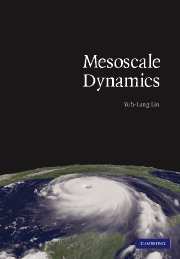Book contents
- Frontmatter
- Contents
- Preface
- 1 Overview
- 2 Governing equations for mesoscale motions
- 3 Basic wave dynamics
- 4 Mesoscale wave generation and maintenance
- 5 Orographically forced flows
- 6 Thermally forced flows
- 7 Mesoscale instabilities
- 8 Isolated convective storms
- 9 Mesoscale convective systems
- 10 Dynamics of fronts and jet streaks
- 11 Dynamics of orographic precipitation
- 12 Basic numerical methods
- 13 Numerical modeling of geophysical fluid systems
- 14 Parameterizations of physical processes
- Appendices
- Index
- References
9 - Mesoscale convective systems
Published online by Cambridge University Press: 15 December 2009
- Frontmatter
- Contents
- Preface
- 1 Overview
- 2 Governing equations for mesoscale motions
- 3 Basic wave dynamics
- 4 Mesoscale wave generation and maintenance
- 5 Orographically forced flows
- 6 Thermally forced flows
- 7 Mesoscale instabilities
- 8 Isolated convective storms
- 9 Mesoscale convective systems
- 10 Dynamics of fronts and jet streaks
- 11 Dynamics of orographic precipitation
- 12 Basic numerical methods
- 13 Numerical modeling of geophysical fluid systems
- 14 Parameterizations of physical processes
- Appendices
- Index
- References
Summary
A mesoscale convective system (MCS) is an organized cluster of thunderstorms, which persists at least for several hours and produces a continguous precipitation area. An MCS may be linear or circular in shape, and is often used to refer to a cluster of thunderstorms that does not satisfy the definition of a mesoscale convective complex (MCC) (Section 9.2). MCSs include squall lines and MCCs in the midlatitudes, and tropical storms (cyclones) and cloud clusters in the tropics. The term mesoscale convective line has also been used to represent a linear form of mesoscale convective systems.
MCSs have a horizontal scale greater than that of an individual thunderstorm, but smaller than the Rossby radius of deformation. The Rossby radius of deformation is defined in (4.2.12) as LR=NLz/f, where Lz is the vertical scale of the motion. In the midlatitudes, LR is approximately 1000km, assuming N=0.01s− 1, Lz=10km, and f=10−4 s− 1. These conditions require the horizontal scale of a MCS to be approximately 100km. Observations have indicated that MCSs have a typical lifetime of 3 hours or more, and their accompaning stratiform clouds may be sustained, or at least remain, for several days. Dynamically, this implies that the Coriolis acceleration is at least comparable to the other terms of the momentum equations, such as the inertial acceleration terms. This gives a time scale of f− 1 (e.g., see Table 1.1), i.e. at least 3h for midlatitude MCSs, which is consistent with observations.
- Type
- Chapter
- Information
- Mesoscale Dynamics , pp. 322 - 378Publisher: Cambridge University PressPrint publication year: 2007



